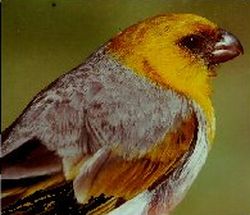Palila v. Hawaii Department of Land and Natural Resources facts for kids
Quick facts for kids Palila v. Hawaii Department of Land and Natural Resources |
|
|---|---|

|
|
| Court | United States Court of Appeals for the Ninth Circuit |
| Full case name | Palila, (Psittirostra bailleui), an endangered species et al. v. Hawaii Department of Land and Natural Resources et al. |
| Decided | February 9, 1981 |
| Citation(s) | Case Citations Case Report |
| Court membership | |
| Judge(s) sitting | Otto Richard Skopil, Jr. (head judge), Betty Binns Fletcher, Harry Pregerson |
| Keywords | |
| Endangered Species Act, Palila, Hawaii Department of Land and Natural Resources, Earthjustice | |
Palila v. Hawaii Department of Land and Natural Resources was an important court case about protecting nature. It focused on the Palila, a rare bird, and its home on Mauna Kea mountain in Hawaiʻi. The problem started when goats and sheep were brought to the island in the late 1700s. These animals became wild, or feral, and began to harm the local plants and animals.
For many years, there was a disagreement between people who wanted to hunt these feral animals and those who wanted to protect the environment. Finally, a lawsuit was filed. It claimed that the state of Hawaii was breaking the Endangered Species Act. The court agreed and ordered the state to remove all feral animals from the island. This case showed how powerful federal laws can be in protecting endangered species.
Contents
Why the Case Started
The story of this case goes back a long time. In the late 1700s, goats and sheep were brought to Hawaiʻi. They escaped and became wild. These feral animals caused a lot of damage to the unique plants and animals that only live in Hawaiʻi. The Palila bird, for example, became very close to extinction.
In the late 1920s, the government started a program to get rid of these feral animals. Their numbers dropped from about 40,000 to just 200 by 1950. However, they were not completely removed. More people started hunting for fun, and they saw the remaining wild animals as game animals.
The Hawaii Department of Land and Natural Resources changed its plan. Instead of getting rid of all the animals, they decided to manage their numbers for hunting. They even brought in new animals, like feral mouflon sheep, for hunters.
There was also a plan to bring in axis deer. Farmers and ranchers worried these deer would eat their crops and spread diseases. Environmental groups also showed that the deer would harm the island's nature. So, the plan to bring in axis deer was stopped.
Conservationists wanted to protect Mauna Kea's ecosystem. They suggested fencing off part of the forests. But many people disagreed, saying it wouldn't work and would be too expensive. While these discussions were happening, the federal Endangered Species Act was passed. This law made it illegal to harm endangered species or their habitats.
Because of this new law, groups like the National Audubon Society and the Sierra Club Legal Defense Fund sued the Hawaii Department of Land and Natural Resources. They said the state was not following federal conservation laws.
Court Hearings
The Main Arguments
The lawsuit was based on the Endangered Species Act. This law protects "critical habitats," which are places where endangered species live and need to survive. The main focus was the Palila bird. This bird is a type of Hawaiian honeycreeper found only in Hawaiʻi.
The Palila used to live on several mountains, but its home had shrunk to only 10% of its original size on Mauna Kea. Many studies showed that the feral goats and sheep were the main reason the Palila was in danger. These studies recommended removing all the feral animals from the mountain. In 1977, the United States Department of the Interior listed the Palila as one of 10 extremely endangered animals.
The state of Hawaii argued that the feral animals were not a threat to the Palila. They also said that the Tenth Amendment to the United States Constitution gave states the power to control non-migratory birds within their own borders.
What the Court Decided
The court decided that the state of Hawaii had broken the Endangered Species Act. It ordered the state to start removing the feral sheep from the island within two years. The state planned to do this through a public hunting program. The state tried to appeal the decision, but their request was denied.
What Happened Next
The court case had several important results:
- It showed that endangered animals have a right to be protected from human actions that harm their homes.
- It proved that the federal government has strong power to protect nature, even in matters that were once only handled by states.
- The court did not question whether endangered species could be part of a lawsuit. The trial court even started its opinion by saying, "The Palila... seeks the protection of this Court..."
While the Palila bird has started to recover from being endangered, many other Hawaiian plants and animals are still in danger. This case set an important example for future efforts to protect nature.
Images for kids
-
Palila (Loxioides bailleui) perched on a mamane tree in Hawaiʻi.


